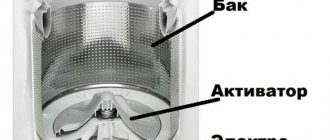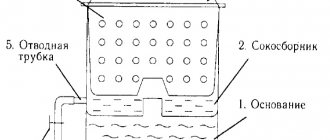What is an inverter microwave oven, how is it different from a regular one? Is it worth overpaying for the benefits promised by consultants? To get to the bottom of the truth, let's understand their structure and find out how a microwave oven with an inverter differs from a simple microwave oven.
Manufacturers claim that such models are much better. Is it true that food cooked in them turns out tastier, more beautiful and retains more nutrients?
Why do you need an inverter?
Even those who do not know physics well understand that in a microwave oven food becomes hot and edible under the influence of ultrahigh frequencies - microwaves. Molecules set in motion by an electromagnetic field release thermal energy. Since the waves are able to penetrate objects through and through, the food in the chamber is evenly heated, not only on the surface, but also inside.
Where do the waves come from in a microwave oven? They are emitted by the magnetron - the “heart” of the device, its main part. In conventional furnaces, the magnetron is powered through a transformer, in these furnaces - from an inverter. This is a control unit and a DC-AC converter. It is in this block that the difference between conventional and inverter systems lies.
Since the inverting element is much smaller than the transformer, there is an advantageous difference in size and weight.
Operating principle of inverter microwave ovens
The magnetron, generating microwaves, gradually reduces the radiation power. The effect on the molecules becomes softer, which prevents them from overheating.
In conventional stoves, the magnetron does not reduce power, but only shortens the intervals of wave impacts and increases the pauses between them. This is more “traumatic” for the molecules; moisture is lost and the product dries out. In an inverter, due to a gradual decrease in radiation, it is possible to preserve the structure of the molecules. What is the practical interest in this for the consumer? Products retain their shape better, they are more attractive on the outside and healthier on the inside.
The essence of technology
An innovative method of cooking food is proposed - Inverter Combination Cooking. This technique eliminates the disadvantages associated with traditional devices. Microwave ovens cook quickly, but only inverter control makes it possible to brown food. By combining a grill or other functions with an inversion system, you can quickly heat and cook food that is healthy and looks delicious.
Accelerated defrosting
Consumers looking at microwave ovens with an inverting element are wondering what Turbo defrosting means. This is a technology that uses the principle of sequentially varying power. Thanks to Turbo mode, food defrosts twice as fast. The “chaos theory” is used, in which it is possible to distribute the energy of microwaves, alternating in the best way the principles of regularity and irregularity.
External differences
If you compare the external data, a device with adjustable power is no different from a regular one, except that it weighs less. All the differences lie in the principle of operation of the device. Thanks to the absence of a bulky transformer, the developers were able to reduce weight and increase the volume of the camera while maintaining external dimensions.
Electricity consumption
A huge advantage of the system is the economical consumption of electricity. The magnetron, which turns on only once per cycle, gradually reduces power, consuming 28% less energy. If standby mode is turned on, savings reach 72%.
Advantages and disadvantages
Like any technology, a microwave oven with an inverting element has its pros and cons. Advantages:
- Compact: spacious chamber, light weight.
- Uniform heating. The control system allows you to smoothly reduce the impact during the cooking process.
- Large set of functions. Dishes are prepared quickly and at the same time remain healthy. By combining microwaves with a grill, you can cook food with a crispy crust, just like in the oven. Microwave radiation can also be combined with steam and other options.
- Fast defrosting. A number of models have this function and defrost food twice as quickly. Since the intensity of the magnetron changes, defrosting occurs in a soft mode - beneficial substances are not destroyed, freshness is better preserved.
- No turntable. The absence of a plate gives more options for placing the container; one thing is important - that it fits in the chamber.
Experts and users find only one drawback with the stoves in question - the price. They are more expensive than regular microwaves. There are also a limited number of modifications.
Advantages and disadvantages
In addition to compactness, microwave ovens with an inverter have a number of undeniable advantages:
- Heating uniformity. Precise control of power and its gradual reduction towards the end of the cooking process ensures uniform heating of food. The difference with the classic MVP is that repeated boiling of water in the product is excluded - the processes are not so “hard” and proceed smoothly. This preserves food at the cellular level and does not destroy vitamins, microelements, beneficial properties, nutritional value and taste of food.
- Versatility and multifunctionality . Inverter control can help in preparing dishes using options that are unusual for a conventional microwave oven. So, you can easily prepare almost any pastry or dish with a crispy golden crust, thanks to the combination of radiation with a grill. Also in the latest models you can combine microwave with steam and other options.
- Accelerated defrosting. Some models have a function for preparing the product for cooking in an accelerated mode. With this defrosting, the intensity of the magnetron operation alternates, which additionally preserves the appearance, freshness and benefits of the frozen product.
- Lack of a rotary table in many models. Often, customers complain that the design does not have a rotating plate, but they have not yet realized their happiness! You can place a dish of any shape in such a chamber - the main thing is that the container is suitable in size. And for uniform heating, rotation is not necessary at all.
What are the disadvantages? There are not many of them, and they usually do not concern the technology itself. First of all, this is a higher cost compared to traditional designs. Experts and buyers also note the limited range of such models.
How much healthier is food from an inverter microwave oven?
The question of the healthfulness of microwave meals has always worried consumers. How true are the claims about the benefits of food cooked in a new type of oven? Any processing negatively affects the usefulness of the products. It is clear that due to the traumatic effects of electromagnetic waves, food loses its original concentration of nutrients - vitamins, minerals, and other nutrients are destroyed.
After repeated experiments and research, experts were able to state that ovens with an inverter operating principle can preserve the content of vitamins and minerals by about 30% more than conventional microwave ovens.
What is an inverter microwave oven?
The latest generation of conventional microwave ovens (a good choice: Panasonic NN-CS894BZPE 32 L) has received approval from users due to its improved method of heating food. Research has revealed that by changing the operating principle of the magnetron, the working part of the device, manufacturers have achieved a more gentle influence of electromagnetic waves on the structure of the product. Due to this, food retains not only the taste, but also the usefulness, appearance and value of the finished dish.
Technological features of inverter models are:
- Unlike a traditional microwave, in which the magnetron operates at full power in a discrete manner, the operating principle of an inverter microwave is different. In it, the magnetron provides a continuous effect of electromagnetic waves on the dish. In this case, the radiation power can be adjusted by selecting a specific cooking mode.
- The absence of a transformer, which is equipped with conventional microwave ovens, made it possible to increase the internal dimensions of the inverter stove;
- Electricity savings range from 25 to 75 percent in different operating modes;
- The functionality has been expanded - a high-speed defrosting mode has been introduced;
- There is no rotating element; the size of the dishes with food is limited only by the volume of the microwave.
When testing the operation of an inverter and a conventional microwave, interesting results were obtained. Having set the same power level in both models, the experimenters placed different foods in them. Milk heated in an inverter stove turned out to be tastier and spilled less than in a regular stove, baked apples retained their shape better, and meat and fish turned out more juicy. The vegetables in it retained their texture, while a conventional microwave oven made them more boiled.
Comparing the internal structure of products processed in two versions of microwave ovens, research specialists from the American Food Institute NFRI made a clear conclusion: inverter technology (such as in the Panasonic NN-DS596MZPE model) retains more liquid inside the product, preventing it from boiling away during the process cooking, which determines the excellent taste, shape and almost imperceptible change in the cellular structure of the dish.
How to choose
The selection criteria are practically no different from the factors taken into account when purchasing a traditional inverter-free model. Need to evaluate:
- dimensions;
- power;
- capacity;
- control;
- functional;
- price.
You also need to consider the expected intensity of use. To heat up ready-made dishes, 0.6 kW is enough - you can buy a solo stove. With additional functions, the power reaches 1.5 kW.
The capacity of the chamber is 14-20 liters. Large volume is recommended for families of 4-5 people. Capacious microwaves are also useful for partygoers who cook for guests.
When choosing a suitable modification, you also need to pay attention to:
- Control. Typically, models with a large range of options use a touch or electronic option - it’s faster, more accurate and more efficient to configure.
- Protection. If there are kids in the family, take a model with a child lock feature.
- Grill. Its functions can be performed by a heating element or a quartz lamp. In the latter case, the dishes seemed to be cooked over a fire. Some models have a vertical or double grill.
- Internal coating. The best option is ceramics or bioceramics. This is an easy to clean material that does not form carbon deposits. Has high resistance to heat and mechanical stress.
Choosing a microwave oven and inverter microwave
Once you find out what the difference is between these units, you can decide on the preferred type of equipment.
General selection criteria for conventional and inverter microwaves:
- power;
- number of modes;
- volume and internal coating of the chamber;
- diameter and type of table or absence of a pallet;
- body material;
- control method;
- equipment;
- additional features: child lock, clock, timer;
- dimensions, weight and design.
Ease of use and ease of maintenance are affected by the type of internal coating of the chamber: it can be ceramic, enamel or stainless steel. All materials are resistant to heat, protected from carbon deposits and are easy to clean in case of contamination.
When choosing, keep in mind that the weight of an inverter microwave oven is less than that of a conventional microwave oven. Although this does not affect the functionality of the appliance, this criterion is important when installing the unit: lighter appliances can be safely placed on a countertop or shelf at eye level.
Who is the manufacturer
The most famous manufacturer of the microwave ovens reviewed is Panasonic.
Panasonic NN-DS596
The described technology is used in the NN-DS596 model, which supports combined mode. Chamber volume - 27 l. Without turntable. There is a powerful steam generator and an upper grill.
Panasonic NN-CD565B
A compact model with a power of 1 kW, not inferior in functionality to full-size versions. Dimensions are reduced due to the special placement of the fan. There is a quartz grill.
Panasonic NN-SD 366 M
Silver-colored stove with a capacity of 22 liters and a power of 0.8 kW. Electronic control. Rotating tray with a diameter of 24.5 cm. Dimensions: 28x48x36 cm.
What Siemens offers
Panasonic is not the only manufacturer of these microwaves; Siemens also produces them. Among the models from this manufacturer, it is worth noting the HF 25M2L2.
Its capacity is 21 liters. The chamber coating is stainless steel. There is defrosting and auto-cooking. Push-button control.
Microwave from Whirlpool
The large AMW 848 IX microwave oven has the most spacious chamber ever: 40 liters. A whole Christmas goose will fit here. The oven has all the functions that a housewife dreams of - grill and convection. Suitable for roasting meat and preparing baked goods. Touch control. There is defrosting and auto-cooking.
Although inverter stoves are produced by a limited number of manufacturers, buyers have plenty to choose from. This technique will be a reliable help in culinary delights.
Advantages and disadvantages of an inverter microwave oven
Despite the fact that inverter microwave ovens are already familiar to a number of buyers, many users are not aware of their advantages. This is facilitated by the small selection of manufacturers of these devices and the lack of widely available information. Therefore, it is important to know which microwave oven is better, more efficient and more functional - inverter or conventional.
In addition to the established fact that inverter ovens preserve the nutritional and taste value of products, many owners note a number of positive operational aspects:
- Convenient and intuitive controls;
- Possibility of power programming;
- In the updated models, due to LEDs, the degree of illumination of the cooking process has been increased: the housewife will see everything that is happening with her dish;
- The absence of a rotary disk makes it possible to use dishes of any shape;
- Some models provide the ability to steam dishes;
- Uniform heating;
- Quiet operation.
These advantages show that the inverter microwave is functional, has low energy consumption, and preserves vitamins and beneficial qualities of products. Some models are also equipped with additional options - steam humidification, grill or convection technology.
Reviews
Panasonic NN-DS596: Oleg I., Sochi
I was interested in a new approach to cooking. I am satisfied with the purchase. The oven has all the main functions - microwaves, steam, grill, convection and plus combinations thereof. There are many advantages. Very quiet operation - you can barely hear the fan. There is self-cleaning. Food cooks much faster. There are no shortcomings, except for fingerprints that remain on the super glossy surface of the control panel.
Siemens HF25G5L2: Valentina T., Stary Oskol
I spent a long time choosing a microwave, I wanted to find the perfect one. I like that there are a bunch of automatic programs: I set a task, and I’m free - the stove will prepare everything itself. Great power - food cooks quickly. The food tastes good, you can't tell it was cooked in a microwave. I can put my favorite recipes into memory. Beautiful design, has a powerful grill - it comes out just like in the oven, with a crispy crust. Defrosts very quickly.
Using a new approach to power management, inverter microwaves produce tastier and healthier food. The equipment itself loses weight and size - these models are lighter, more compact and more spacious. The only negative is the higher price. But the benefits you get from the purchase are worth it.
Advantages of inverter and conventional microwave ovens
- quick heating and defrosting;
- Ease of Management;
- compact dimensions;
- attractive design;
- ease of care.
Pros of an inverter microwave:
- automatic sequential power control, which speeds up heating and cooking by 2 times;
- maintaining the benefits and improving the quality of ready-made dishes;
- uniform heat treatment of products;
- rational use of free space in the kitchen;
- reduced weight;
- optimal energy consumption;
- saving cooking time.
REDMOND microwaves have received many positive customer reviews:
“It’s a successful microwave: it looks nice and the volume is sufficient. The grill cooks well. He did an excellent job with a small chicken in the combi mode (grill + micra). It's good that there is a child lock. “And then my children and my grandmother tried to put something metal in the microwave.”
"Like. Plus - there is a function and a grill grate, the chicken turns out excellent, especially if it has been marinated enough time. I’ve adapted to cooking root vegetables in it (putting them in a bag, sealing them for a maximum of 8 minutes), and baking muffins, and baking vegetables.”
“I fell in love with its design at first sight, and when I studied the functionality, I realized what I needed to take. A very powerful oven, even the grill pleasantly surprised me with the speed of cooking the meat.”











